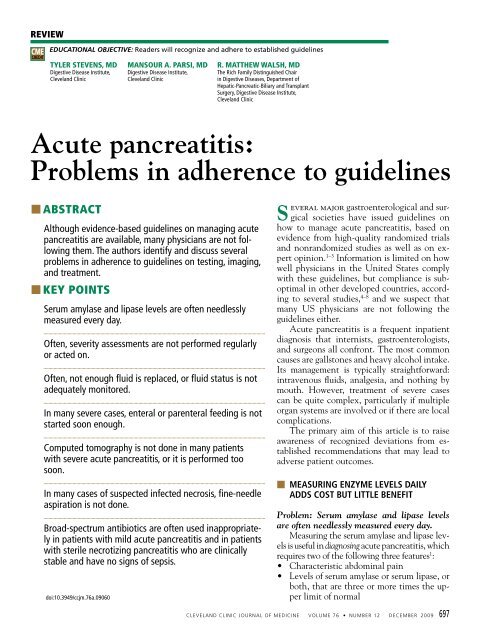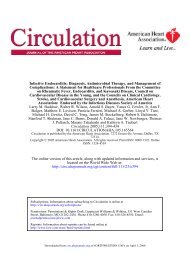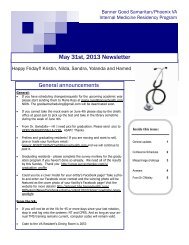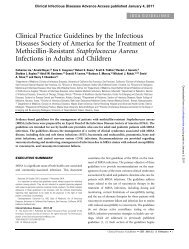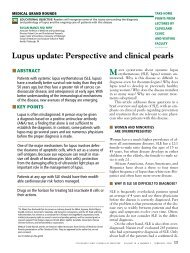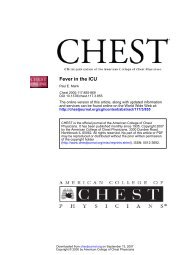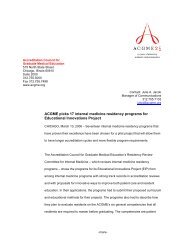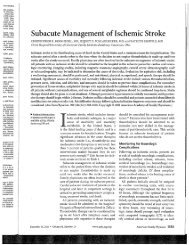Acute pancreatitis: Problems in adherence to guidelines - Cleveland ...
Acute pancreatitis: Problems in adherence to guidelines - Cleveland ...
Acute pancreatitis: Problems in adherence to guidelines - Cleveland ...
You also want an ePaper? Increase the reach of your titles
YUMPU automatically turns print PDFs into web optimized ePapers that Google loves.
REVIEW<br />
CME<br />
CREDIT<br />
EDUCATIONAL OBJECTIVE: Readers will recognize and adhere <strong>to</strong> established guidel<strong>in</strong>es<br />
Tyler Stevens, MD<br />
Digestive Disease Institute,<br />
<strong>Cleveland</strong> Cl<strong>in</strong>ic<br />
Mansour A. Parsi, MD<br />
Digestive Disease Institute,<br />
<strong>Cleveland</strong> Cl<strong>in</strong>ic<br />
R. Matthew Walsh, MD<br />
The Rich Family Dist<strong>in</strong>guished Chair<br />
<strong>in</strong> Digestive Diseases, Department of<br />
Hepatic-Pancreatic-Biliary and Transplant<br />
Surgery, Digestive Disease Institute,<br />
<strong>Cleveland</strong> Cl<strong>in</strong>ic<br />
<strong>Acute</strong> <strong>pancreatitis</strong>:<br />
<strong>Problems</strong> <strong>in</strong> <strong>adherence</strong> <strong>to</strong> guidel<strong>in</strong>es<br />
■■Abstract<br />
Although evidence-based guidel<strong>in</strong>es on manag<strong>in</strong>g acute<br />
<strong>pancreatitis</strong> are available, many physicians are not follow<strong>in</strong>g<br />
them. The authors identify and discuss several<br />
problems <strong>in</strong> <strong>adherence</strong> <strong>to</strong> guidel<strong>in</strong>es on test<strong>in</strong>g, imag<strong>in</strong>g,<br />
and treatment.<br />
■■KEY POINTS<br />
Serum amylase and lipase levels are often needlessly<br />
measured every day.<br />
Often, severity assessments are not performed regularly<br />
or acted on.<br />
Often, not enough fluid is replaced, or fluid status is not<br />
adequately moni<strong>to</strong>red.<br />
In many severe cases, enteral or parenteral feed<strong>in</strong>g is not<br />
started soon enough.<br />
Computed <strong>to</strong>mography is not done <strong>in</strong> many patients<br />
with severe acute <strong>pancreatitis</strong>, or it is performed <strong>to</strong>o<br />
soon.<br />
In many cases of suspected <strong>in</strong>fected necrosis, f<strong>in</strong>e-needle<br />
aspiration is not done.<br />
Broad-spectrum antibiotics are often used <strong>in</strong>appropriately<br />
<strong>in</strong> patients with mild acute <strong>pancreatitis</strong> and <strong>in</strong> patients<br />
with sterile necrotiz<strong>in</strong>g <strong>pancreatitis</strong> who are cl<strong>in</strong>ically<br />
stable and have no signs of sepsis.<br />
doi:10.3949/ccjm.76a.09060<br />
everal major gastroenterological and surgical<br />
societies have issued guidel<strong>in</strong>es on<br />
S<br />
how <strong>to</strong> manage acute <strong>pancreatitis</strong>, based on<br />
evidence from high-quality randomized trials<br />
and nonrandomized studies as well as on expert<br />
op<strong>in</strong>ion. 1–3 Information is limited on how<br />
well physicians <strong>in</strong> the United States comply<br />
with these guidel<strong>in</strong>es, but compliance is suboptimal<br />
<strong>in</strong> other developed countries, accord<strong>in</strong>g<br />
<strong>to</strong> several studies, 4–8 and we suspect that<br />
many US physicians are not follow<strong>in</strong>g the<br />
guidel<strong>in</strong>es either.<br />
<strong>Acute</strong> <strong>pancreatitis</strong> is a frequent <strong>in</strong>patient<br />
diagnosis that <strong>in</strong>ternists, gastroenterologists,<br />
and surgeons all confront. The most common<br />
causes are galls<strong>to</strong>nes and heavy alcohol <strong>in</strong>take.<br />
Its management is typically straightforward:<br />
<strong>in</strong>travenous fluids, analgesia, and noth<strong>in</strong>g by<br />
mouth. However, treatment of severe cases<br />
can be quite complex, particularly if multiple<br />
organ systems are <strong>in</strong>volved or if there are local<br />
complications.<br />
The primary aim of this article is <strong>to</strong> raise<br />
awareness of recognized deviations from established<br />
recommendations that may lead <strong>to</strong><br />
adverse patient outcomes.<br />
■■ Measur<strong>in</strong>g ENZYME LEVELS daily<br />
ADDs COST BUT LITTLE BENEFIT<br />
Problem: Serum amylase and lipase levels<br />
are often needlessly measured every day.<br />
Measur<strong>in</strong>g the serum amylase and lipase levels<br />
is useful <strong>in</strong> diagnos<strong>in</strong>g acute <strong>pancreatitis</strong>, which<br />
requires two of the follow<strong>in</strong>g three features 1 :<br />
• Characteristic abdom<strong>in</strong>al pa<strong>in</strong><br />
• Levels of serum amylase or serum lipase, or<br />
both, that are three or more times the upper<br />
limit of normal<br />
CLEVELAND CLINIC JOURNAL OF MEDICINE VOLUME 76 • NUMBER 12 DECEMBER 2009 697
<strong>Acute</strong> PancreatitiS<br />
The serum<br />
enzyme level<br />
does not<br />
correlate with<br />
the severity<br />
of the attack<br />
TABLE 1<br />
The Ranson score for assess<strong>in</strong>g<br />
acute <strong>pancreatitis</strong><br />
On admission<br />
Age > 55 years<br />
White blood cell count > 16,000/mL<br />
Lactate dehydrogenase > 350 IU/L<br />
Aspartate am<strong>in</strong>otransferase > 250 IU/L<br />
Glucose > 200 mg/dL<br />
At 48 hours<br />
Hema<strong>to</strong>crit decrease > 10%<br />
Blood urea nitrogen <strong>in</strong>crease > 5 mg/dL<br />
Calcium < 8 mg/dL<br />
Partial pressure of oxygen, arterial < 60 mm Hg<br />
Base deficit > 4 mg/dL<br />
Fluid sequestration > 6 L<br />
The presence of three or more fac<strong>to</strong>rs predicts a higher risk<br />
of death or serious illness.<br />
BASED ON INFORMATION IN Ranson JH, Rifk<strong>in</strong>d KM, Roses DF,<br />
F<strong>in</strong>k SD, Eng K, Spencer FC. Prognostic signs and the role of<br />
operative management <strong>in</strong> acute <strong>pancreatitis</strong>.<br />
Surg Gynecol Obstet 1974; 139:69–81.<br />
• F<strong>in</strong>d<strong>in</strong>gs of acute <strong>pancreatitis</strong> on computed<br />
<strong>to</strong>mography (CT).<br />
However, the magnitude or duration of<br />
the serum enzyme elevation does not correlate<br />
with the severity of the attack. Further, we<br />
have noticed that physicians at our hospital<br />
often order daily serum amylase and lipase levels<br />
<strong>in</strong> patients admitted with acute <strong>pancreatitis</strong>.<br />
The American College of Gastroenterology<br />
(ACG) guidel<strong>in</strong>es 1 state that daily moni<strong>to</strong>r<strong>in</strong>g<br />
of amylase and lipase has limited value<br />
<strong>in</strong> manag<strong>in</strong>g acute <strong>pancreatitis</strong>. Recheck<strong>in</strong>g<br />
these concentrations may be reasonable if pa<strong>in</strong><br />
fails <strong>to</strong> resolve or worsens dur<strong>in</strong>g a prolonged<br />
hospitalization, as this may suggest a recurrent<br />
attack of acute <strong>pancreatitis</strong> or a develop<strong>in</strong>g<br />
pseudocyst. But <strong>in</strong> most cases of acute <strong>pancreatitis</strong>,<br />
daily serum enzyme measurements add<br />
cost but little benefit.<br />
■■ REGULAR ASSESSMENT IS IMPORTANT<br />
Problem: Often, severity assessments are not<br />
performed regularly or acted on.<br />
Most cases of acute <strong>pancreatitis</strong> are mild,<br />
with rapid recovery and excellent prognosis.<br />
However, 15% <strong>to</strong> 20% are severe and may<br />
result <strong>in</strong> a prolonged hospitalization, systemic<br />
<strong>in</strong>flamma<strong>to</strong>ry response syndrome (SIRS),<br />
multiorgan system failure, and death.<br />
In severe acute <strong>pancreatitis</strong>, as pancreatic<br />
enzymes and <strong>in</strong>flamma<strong>to</strong>ry cy<strong>to</strong>k<strong>in</strong>es damage<br />
the blood vessels, a vast amount of fluid leaks<br />
out <strong>in</strong><strong>to</strong> the <strong>in</strong>terstitial (“third”) space. This<br />
fluid extravasation leads <strong>to</strong> decreased effective<br />
circulat<strong>in</strong>g volume, local pancreatic necrosis,<br />
hemodynamic <strong>in</strong>stability, and end-organ failure.<br />
It is important <strong>to</strong> recognize severe acute<br />
<strong>pancreatitis</strong> early because the patient needs <strong>to</strong><br />
be transferred <strong>to</strong> a step-down unit or <strong>in</strong>tensive<br />
care unit <strong>to</strong> receive optimal fluid resuscitation<br />
and supportive care for organ dysfunction. After<br />
48 <strong>to</strong> 72 hours, a prediction of severe acute<br />
<strong>pancreatitis</strong> should also prompt the physician<br />
<strong>to</strong> order CT <strong>to</strong> detect pancreatic necrosis, and<br />
also <strong>to</strong> <strong>in</strong>itiate nutritional support.<br />
Assessment of severity beg<strong>in</strong>s <strong>in</strong> the emergency<br />
room or on admission <strong>to</strong> the hospital.<br />
Older age, obesity, organ failure, and pulmonary<br />
<strong>in</strong>filtrates or pleural effusions are <strong>in</strong>itial<br />
<strong>in</strong>dica<strong>to</strong>rs of poor prognosis. Signs of SIRS<br />
(high or low core body temperature, tachycardia,<br />
tachypnea, low or high peripheral white<br />
blood cell count) or organ failure (eg, elevated<br />
serum creat<strong>in</strong><strong>in</strong>e) are present on admission <strong>in</strong><br />
21% of patients with acute <strong>pancreatitis</strong>. 9<br />
Hemoconcentration is a marker of decreased<br />
effective circulat<strong>in</strong>g volume <strong>in</strong> severe<br />
acute <strong>pancreatitis</strong>. A hema<strong>to</strong>crit higher than<br />
44% at admission or that rises <strong>in</strong> the first 24<br />
<strong>to</strong> 48 hours of admission predicts necrosis. 10,11<br />
However, a more robust marker of organ failure<br />
may be the blood urea nitrogen level. 12<br />
Cl<strong>in</strong>ical scor<strong>in</strong>g systems<br />
Several cl<strong>in</strong>ical scor<strong>in</strong>g systems have been<br />
studied for assess<strong>in</strong>g severity.<br />
The Ranson score is based on 11 cl<strong>in</strong>ical<br />
fac<strong>to</strong>rs, 5 checked at admission and 6 checked<br />
at 48 hours (Table 1). Patients are at higher<br />
risk of death or “serious illness” (need<strong>in</strong>g 7 or<br />
more days of <strong>in</strong>tensive care) if they have 3 or<br />
more of these fac<strong>to</strong>rs. 13 In a meta-analysis of<br />
12 studies, a Ranson score of 3 or higher had a<br />
sensitivity of 75% and a specificity of 77% for<br />
predict<strong>in</strong>g severe acute <strong>pancreatitis</strong>. 14<br />
Limitations of the Ranson score are that<br />
698 CLEVELAND CLINIC JOURNAL OF MEDICINE VOLUME 76 • NUMBER 12 DECEMBER 2009
Stevens and Colleagues<br />
it can only be completed after 48 hours, all<br />
the data po<strong>in</strong>ts are not always obta<strong>in</strong>ed, and<br />
it cannot be repeated on a daily basis. Ow<strong>in</strong>g<br />
<strong>to</strong> these limitations and its less-than-optimal<br />
predictive value, the Ranson score has fallen<br />
<strong>in</strong><strong>to</strong> disuse.<br />
The APACHE II (<strong>Acute</strong> Physiology and<br />
Chronic Health Evaluation II) score is more<br />
versatile. It is based on multiple cl<strong>in</strong>ical and<br />
labora<strong>to</strong>ry values, and it correlates very well<br />
with the risk of death <strong>in</strong> acute <strong>pancreatitis</strong>.<br />
Death rates are less than 4% when the<br />
APACHE II score is less than 8, and 11% <strong>to</strong><br />
18% when it is 8 or higher. 1 The trajec<strong>to</strong>ry of<br />
the APACHE II score <strong>in</strong> the first 48 hours is<br />
also an accurate prognostic <strong>in</strong>dica<strong>to</strong>r.<br />
Previous limitations of the APACHE II<br />
score were that it was complicated and timeconsum<strong>in</strong>g<br />
<strong>to</strong> calculate and required arterial<br />
blood gas measurements. Easy-<strong>to</strong>-use onl<strong>in</strong>e<br />
calcula<strong>to</strong>rs are now available (eg, www.<br />
globalrph.com/apacheii.htm), and the venous<br />
bicarbonate level and the oxygen saturation<br />
can be substituted for the arterial pH and oxygen<br />
partial pressure.<br />
BISAP, a new five-po<strong>in</strong>t scor<strong>in</strong>g system, 15<br />
was recently prospectively validated. 12<br />
“BISAP” is an acronym for the five markers it<br />
is based on, each of which has been shown <strong>to</strong><br />
predict severe illness <strong>in</strong> acute <strong>pancreatitis</strong>:<br />
• Blood urea nitrogen level > 25 mg/dL<br />
• Impaired mental status<br />
• SIRS<br />
• Age > 60 years<br />
• Pleural effusion.<br />
The presence of three or more of these fac<strong>to</strong>rs<br />
correlates with higher risk of death, organ<br />
failure, and pancreatic necrosis. 12<br />
Compared with APACHE II, BISAP has<br />
similar accuracy and is easier <strong>to</strong> calculate.<br />
Also, BISAP was specifically developed for<br />
acute <strong>pancreatitis</strong>, whereas APACHE II is a<br />
generic score for all critically ill patients.<br />
The Atlanta criteria 16 def<strong>in</strong>e severe acute<br />
<strong>pancreatitis</strong> as one or more of the follow<strong>in</strong>g:<br />
• A Ranson score of 3 or higher dur<strong>in</strong>g the<br />
first 48 hours<br />
• An APACHE II score of 8 or higher at any<br />
time<br />
• Failure of one or more organs<br />
• One or more local complications (eg, necrosis,<br />
pseudocysts, abscesses).<br />
Recommendation:<br />
Assess severity at least daily<br />
A severity assessment should be performed at<br />
admission and at least every day thereafter.<br />
Cl<strong>in</strong>ical guidel<strong>in</strong>es recognize the importance<br />
of severity assessment but vary <strong>in</strong> their specific<br />
recommendations.<br />
The ACG advises calculat<strong>in</strong>g the<br />
APACHE II score with<strong>in</strong> 3 days of admission<br />
and measur<strong>in</strong>g the hema<strong>to</strong>crit at admission, at<br />
12 hours, and at 24 hours. The level of evidence<br />
is III, ie, “from published well-designed<br />
trials without randomization, s<strong>in</strong>gle group<br />
prepost, cohort, time series, or matched case<br />
controlled studies”. 1<br />
The American Gastroenterological Association<br />
(AGA) provides a more generalized<br />
recommendation, that “cl<strong>in</strong>ical judgment”<br />
should take <strong>in</strong><strong>to</strong> account the presence of risk<br />
fac<strong>to</strong>rs (eg, age, obesity), presence or absence<br />
of SIRS, rout<strong>in</strong>e labora<strong>to</strong>ry values (eg, hema<strong>to</strong>crit,<br />
serum creat<strong>in</strong><strong>in</strong>e), and APACHE II<br />
score when assess<strong>in</strong>g severity and mak<strong>in</strong>g decisions.<br />
2<br />
In a German survey, only 32% of gastroenterologists<br />
used the APACHE II score for<br />
assess<strong>in</strong>g risk <strong>in</strong> acute <strong>pancreatitis</strong>, <strong>in</strong> spite<br />
of national guidel<strong>in</strong>es emphasiz<strong>in</strong>g its importance.<br />
7 Also, not all patients with severe acute<br />
<strong>pancreatitis</strong> are transferred <strong>to</strong> a step-down<br />
unit or <strong>in</strong>tensive care unit as recommended.<br />
In a British study, 4 only 8 (17%) of 46 patients<br />
with predicted severe acute <strong>pancreatitis</strong> were<br />
transferred, and 8 of the 38 patients who were<br />
not transferred died.<br />
■■ Fluid must be aggressively<br />
replaced and moni<strong>to</strong>red<br />
Problem: Often, not enough fluid is replaced,<br />
or fluid status is not adequately moni<strong>to</strong>red.<br />
Fluid must be aggressively replaced <strong>to</strong> balance<br />
the massive third-space fluid losses that<br />
occur <strong>in</strong> the early <strong>in</strong>flamma<strong>to</strong>ry phase of acute<br />
<strong>pancreatitis</strong>. Intravascular volume depletion<br />
can develop rapidly and result <strong>in</strong> tachycardia,<br />
hypotension, and renal failure. It may also impair<br />
the blood flow <strong>to</strong> the pancreas and worsen<br />
necrosis.<br />
Animal studies show that aggressive fluid<br />
replacement supports the pancreatic microcirculation<br />
and prevents necrosis. 17 It may also<br />
There is<br />
massive fluid<br />
sequestration<br />
<strong>in</strong> severe acute<br />
<strong>pancreatitis</strong><br />
CLEVELAND CLINIC JOURNAL OF MEDICINE VOLUME 76 • NUMBER 12 DECEMBER 2009 699
<strong>Acute</strong> PancreatitiS<br />
Assessment<br />
of severity<br />
beg<strong>in</strong>s <strong>in</strong> the<br />
emergency<br />
room or<br />
on hospital<br />
admission<br />
support the <strong>in</strong>test<strong>in</strong>al microcirculation and<br />
gut barrier, prevent<strong>in</strong>g bacterial translocation.<br />
In humans, no controlled trials have been<br />
done <strong>to</strong> test the efficacy of aggressive fluid<br />
resuscitation <strong>in</strong> acute <strong>pancreatitis</strong>. However,<br />
the notion that <strong>in</strong>travascular fluid loss contributes<br />
<strong>to</strong> poor outcomes is <strong>in</strong>ferred from human<br />
studies show<strong>in</strong>g more necrosis and deaths<br />
<strong>in</strong> patients with hemoconcentration. In one<br />
study, patients who received <strong>in</strong>adequate fluid<br />
replacement (evidenced by a rise <strong>in</strong> hema<strong>to</strong>crit<br />
at 24 hours) were more likely <strong>to</strong> develop<br />
necrotiz<strong>in</strong>g <strong>pancreatitis</strong>. 18<br />
Recommendation:<br />
Early, aggressive fluid replacement<br />
Experts have suggested <strong>in</strong>itially <strong>in</strong>fus<strong>in</strong>g 500<br />
<strong>to</strong> 1,000 mL of fluid per hour <strong>in</strong> those who are<br />
volume-depleted, <strong>in</strong>itially <strong>in</strong>fus<strong>in</strong>g 250 <strong>to</strong> 350<br />
mL per hour <strong>in</strong> those who are not volumedepleted,<br />
and adjust<strong>in</strong>g the fluid rate every 1<br />
<strong>to</strong> 4 hours on the basis of cl<strong>in</strong>ical variables. 19<br />
The sufficiency of fluid replacement should be<br />
carefully moni<strong>to</strong>red by vital signs, ur<strong>in</strong>e output,<br />
and serum hema<strong>to</strong>crit.<br />
On the other hand, overly aggressive fluid<br />
resuscitation can be detrimental <strong>in</strong> patients at<br />
risk of volume overload or pulmonary edema.<br />
Fluid replacement should be tempered <strong>in</strong> elderly<br />
patients and those with cardiac or renal<br />
comorbidities, and may require moni<strong>to</strong>r<strong>in</strong>g of<br />
central venous pressure.<br />
The ACG and AGA guidel<strong>in</strong>es both recognize<br />
the need for early aggressive volume<br />
replacement <strong>in</strong> acute <strong>pancreatitis</strong> (level of<br />
evidence III), but they do not specify the exact<br />
amounts and rates. Young and healthy patients<br />
should receive a rapid bolus of iso<strong>to</strong>nic<br />
sal<strong>in</strong>e or R<strong>in</strong>ger’s lactate solution followed<br />
by an <strong>in</strong>fusion at a high <strong>in</strong>itial ma<strong>in</strong>tenance<br />
rate.<br />
Few studies have been done <strong>to</strong> assess physicians’<br />
compliance with recommendations for<br />
aggressive volume replacement. In an Italian<br />
multicenter study, patients with mild or severe<br />
acute <strong>pancreatitis</strong> received an average of only<br />
2.5 L of fluid per day (about 100 mL/hour). 20<br />
Gardner et al 21 recently summarized the available<br />
evidence for fluid support <strong>in</strong> acute <strong>pancreatitis</strong>.<br />
■■ Nutritional support<br />
Problem: In many severe cases, enteral or parenteral<br />
feed<strong>in</strong>g is not started soon enough.<br />
Nutritional support entails enteral or parenteral<br />
feed<strong>in</strong>g when an oral diet is contra<strong>in</strong>dicated.<br />
Enteral feed<strong>in</strong>g is usually via a nasojejunal<br />
tube, which may need <strong>to</strong> be placed<br />
under endoscopic or radiographic guidance.<br />
Neither parenteral nor nasojejunal feed<strong>in</strong>g<br />
stimulates pancreatic secretion, and both are<br />
safe <strong>in</strong> acute <strong>pancreatitis</strong>.<br />
Severe acute <strong>pancreatitis</strong> is an <strong>in</strong>tensely<br />
catabolic state characterized by <strong>in</strong>creased<br />
energy expenditure, prote<strong>in</strong> breakdown, and<br />
substrate utilization. Patients may not be<br />
able <strong>to</strong> resume an oral diet for weeks or even<br />
months, particularly if local complications<br />
develop. Early nutritional support has been<br />
shown <strong>to</strong> improve outcomes <strong>in</strong> severe acute<br />
<strong>pancreatitis</strong>. 22 Therefore, nutritional support<br />
should be started as soon as possible <strong>in</strong> severe<br />
acute <strong>pancreatitis</strong> based on <strong>in</strong>itial cl<strong>in</strong>ical and<br />
radiographic <strong>in</strong>dica<strong>to</strong>rs of severity, optimally<br />
with<strong>in</strong> the first 2 or 3 days.<br />
Enteral nutrition is preferred <strong>to</strong> parenteral<br />
nutrition <strong>in</strong> <strong>pancreatitis</strong>: it is less expensive<br />
and does not pose a risk of catheter-related <strong>in</strong>fection<br />
or thrombosis or hepatic complications.<br />
Also, there is experimental evidence that enteral<br />
nutrition may preserve the gut barrier,<br />
decreas<strong>in</strong>g mucosal permeability and bacterial<br />
translocation.<br />
A number of small randomized trials compared<br />
enteral and parenteral nutrition <strong>in</strong> acute<br />
<strong>pancreatitis</strong>, but they yielded mixed results. A<br />
meta-analysis of six trials showed a lower rate<br />
of <strong>in</strong>fectious complications with enteral than<br />
with parenteral nutrition. 23 However, no significant<br />
difference was found <strong>in</strong> the rates of<br />
death or non<strong>in</strong>fectious complications.<br />
Recommendation:<br />
Enteral feed<strong>in</strong>g, when possible<br />
Nutritional support is unnecessary <strong>in</strong> most<br />
cases of mild acute <strong>pancreatitis</strong>. Pancreatic<br />
<strong>in</strong>flammation typically resolves with<strong>in</strong> a few<br />
days, allow<strong>in</strong>g patients <strong>to</strong> resume eat<strong>in</strong>g. Occasionally,<br />
patients <strong>in</strong> whom pa<strong>in</strong> resolves<br />
slowly and who fast for more than 5 <strong>to</strong> 7 days<br />
need nutritional support <strong>to</strong> prevent prote<strong>in</strong>calorie<br />
malnutrition.<br />
700 CLEVELAND CLINIC JOURNAL OF MEDICINE VOLUME 76 • NUMBER 12 DECEMBER 2009
Stevens and Colleagues<br />
The ACG guidel<strong>in</strong>es 1 and most others suggest<br />
that, whenever possible, enteral rather<br />
than parenteral feed<strong>in</strong>g should be given <strong>to</strong><br />
those who require nutritional support. The<br />
level of evidence is II (“strong evidence from<br />
at least one published properly designed randomized<br />
controlled trial of appropriate size<br />
and <strong>in</strong> an appropriate cl<strong>in</strong>ical sett<strong>in</strong>g”).<br />
However, not all physicians recognize the<br />
benefit of enteral feed<strong>in</strong>g. In a cohort of German<br />
gastroenterologists, only 73% favored<br />
enteral over parenteral feed<strong>in</strong>g <strong>in</strong> acute <strong>pancreatitis</strong>.<br />
7<br />
■■ COMPUTED TOMOGRAPHY<br />
Problem: CT is not done <strong>in</strong> many patients<br />
with severe acute <strong>pancreatitis</strong>, or it is done<br />
<strong>to</strong>o soon dur<strong>in</strong>g the admission.<br />
Dual-phase, contrast-enhanced, pancreatic-pro<strong>to</strong>col<br />
CT provides a sensitive structural<br />
evaluation of the pancreas and is useful <strong>to</strong><br />
diagnose necrotiz<strong>in</strong>g <strong>pancreatitis</strong>. Pancreatic<br />
necrosis is correlated with a severe cl<strong>in</strong>ical<br />
course, the development of s<strong>in</strong>gle or multiorgan<br />
dysfunction, and death.<br />
Necrosis is diagnosed when more than 30%<br />
of the pancreas does not enhance (ie, perfuse)<br />
after <strong>in</strong>travenous contrast is given. The Balthazar-Ranson<br />
CT severity <strong>in</strong>dex <strong>in</strong>cludes the<br />
degree of pancreatic enlargement and <strong>in</strong>flammation,<br />
presence and number of fluid collections,<br />
and degree of necrosis (Table 2). 24<br />
Recommendation: CT <strong>in</strong> severe cases<br />
Not every patient with acute <strong>pancreatitis</strong><br />
needs <strong>to</strong> undergo CT. Most mild cases do not<br />
require rout<strong>in</strong>e CT, s<strong>in</strong>ce necrosis and other<br />
local complications are <strong>in</strong>frequent <strong>in</strong> this<br />
group.<br />
Also, CT is often ordered <strong>to</strong>o soon dur<strong>in</strong>g<br />
the hospitalization. Indica<strong>to</strong>rs of severity on<br />
CT are not usually evident until 2 <strong>to</strong> 3 days<br />
after admission. 25 CT should be considered<br />
about 3 days after the onset of symp<strong>to</strong>ms rather<br />
than immediately upon admission.<br />
On the other hand, CT at the time of admission<br />
may be warranted <strong>to</strong> rule out other<br />
life-threaten<strong>in</strong>g causes of abdom<strong>in</strong>al pa<strong>in</strong> and<br />
hyperamylasemia (eg, bowel obstruction, viscus<br />
perforation). CT may also be useful <strong>in</strong> the<br />
late phase of acute <strong>pancreatitis</strong> (weeks after<br />
TABLE 2<br />
The Balthazar-Ranson severity<br />
<strong>in</strong>dex for acute <strong>pancreatitis</strong><br />
f<strong>in</strong>d<strong>in</strong>gs on Computed Tomography Score *<br />
Normal 0<br />
Focal or diffuse enlargement of the pancreas 1<br />
Intr<strong>in</strong>sic pancreatic abnormalities associated with haz<strong>in</strong>ess 2<br />
and streaky densities represent<strong>in</strong>g <strong>in</strong>flamma<strong>to</strong>ry changes <strong>in</strong><br />
the peripancreatic fat<br />
S<strong>in</strong>gle, ill-def<strong>in</strong>ed fluid collection 3<br />
Two or more fluid collections 4<br />
No necrosis 0<br />
1/3 necrosis 2<br />
1/2 necrosis 4<br />
> 1/2 necrosis 6<br />
*<br />
Almost all patients with a <strong>to</strong>tal score of 7 or higher develop complications, and<br />
17% of them die.<br />
Based on <strong>in</strong>formation <strong>in</strong> Balthazar EJ, Rob<strong>in</strong>son DL, Megibow AJ, Ranson JH. <strong>Acute</strong><br />
<strong>pancreatitis</strong>: value of CT <strong>in</strong> establish<strong>in</strong>g prognosis. Radiology 1990; 174:331–336.<br />
admission) <strong>to</strong> diagnose or moni<strong>to</strong>r complications<br />
(eg, pseudocysts, abscesses, splenic ve<strong>in</strong><br />
thrombosis, splenic artery pseudoaneurysms).<br />
Magnetic resonance imag<strong>in</strong>g with gadol<strong>in</strong>ium<br />
contrast is a reasonable alternative <strong>to</strong> CT for<br />
detect<strong>in</strong>g pancreatic necrosis and other local<br />
complications.<br />
In patients who have severe acute <strong>pancreatitis</strong><br />
and compromised renal function (serum<br />
creat<strong>in</strong><strong>in</strong>e > 1.5 mg/dL), CT can be performed<br />
without contrast <strong>to</strong> assess severity based on a<br />
limited Balthazar score (ie, without a necrosis<br />
score). Studies <strong>in</strong> rats suggest that iod<strong>in</strong>ated<br />
contrast may decrease pancreatic microcirculation<br />
and worsen or precipitate necrosis, 26<br />
although published human studies do not support<br />
this contention. 27,28<br />
Guidel<strong>in</strong>es uniformly recommend CT for<br />
patients with severe acute <strong>pancreatitis</strong> (the<br />
ACG guidel<strong>in</strong>e gives it a level of evidence of<br />
III), but this recommendation is not always<br />
followed. A study from Australia showed that<br />
CT was done <strong>in</strong> only 27% <strong>to</strong> 67% of patients<br />
with severe acute <strong>pancreatitis</strong>. 5 In a British<br />
study, only 8 of 46 patients with cl<strong>in</strong>ically<br />
predicted severe <strong>pancreatitis</strong> underwent CT<br />
with<strong>in</strong> the first 10 days of admission. 4<br />
Severe<br />
acute<br />
<strong>pancreatitis</strong><br />
is an <strong>in</strong>tensely<br />
catabolic state<br />
CLEVELAND CLINIC JOURNAL OF MEDICINE VOLUME 76 • NUMBER 12 DECEMBER 2009 701
<strong>Acute</strong> PancreatitiS<br />
Prophylactic use<br />
of antibiotics <strong>in</strong><br />
sterile necrosis<br />
is controversial<br />
■■ suspected <strong>in</strong>fected necrosis<br />
Problem: F<strong>in</strong>e-needle aspiration is not done<br />
<strong>in</strong> many cases of suspected <strong>in</strong>fected necrosis.<br />
Approximately one-third of patients with<br />
necrotiz<strong>in</strong>g <strong>pancreatitis</strong> develop <strong>in</strong>fected necrosis.<br />
The death rate for patients with <strong>in</strong>fected<br />
pancreatic necrosis is high—30%, compared<br />
with 12% <strong>in</strong> those with sterile necrosis. 1<br />
Differentiat<strong>in</strong>g sterile and <strong>in</strong>fected necrosis is<br />
therefore essential.<br />
Cl<strong>in</strong>ical signs such as fever are poor predic<strong>to</strong>rs<br />
of <strong>in</strong>fection. Signs of SIRS can be present<br />
<strong>in</strong> both sterile and <strong>in</strong>fected necrotiz<strong>in</strong>g <strong>pancreatitis</strong>.<br />
Recommendation:<br />
F<strong>in</strong>e-needle aspiration of necrosis<br />
For the reasons given above, the f<strong>in</strong>d<strong>in</strong>gs of<br />
necrosis on CT and persistent SIRS should<br />
prompt consideration of f<strong>in</strong>e-needle aspiration<br />
with Gram sta<strong>in</strong> and culture <strong>to</strong> differentiate<br />
sterile and <strong>in</strong>fected necrosis (ACG<br />
guidel<strong>in</strong>e, level of evidence III). 1 If <strong>in</strong>fection<br />
is confirmed, surgical debridement should be<br />
strongly considered. Other less-<strong>in</strong>vasive approaches<br />
such as endoscopic debridement can<br />
be used <strong>in</strong> selected cases.<br />
F<strong>in</strong>e-needle aspiration of necrosis is <strong>to</strong>o<br />
often neglected. In a cohort of German surgeons,<br />
only 55% complied with International<br />
Association of Pancrea<strong>to</strong>logy recommendations<br />
<strong>to</strong> perform biopsy <strong>to</strong> differentiate sterile<br />
from <strong>in</strong>fected necrosis <strong>in</strong> patients with signs of<br />
sepsis. 29<br />
■■ Broad-spectrum antibiotics<br />
Problem: Broad-spectrum antibiotics are<br />
often used <strong>in</strong>appropriately <strong>in</strong> patients with<br />
mild acute <strong>pancreatitis</strong> and <strong>in</strong> patients with<br />
sterile necrotiz<strong>in</strong>g <strong>pancreatitis</strong> who are cl<strong>in</strong>ically<br />
stable and have no signs of sepsis.<br />
Antibiotics are not <strong>in</strong>dicated <strong>in</strong> mild acute<br />
<strong>pancreatitis</strong>. A limited course of antibiotics is<br />
typically <strong>in</strong>dicated <strong>in</strong> severe cases with suspected<br />
or proven <strong>in</strong>fected necrosis (<strong>in</strong> conjunction<br />
with surgical necrosec<strong>to</strong>my). However,<br />
the use of antibiotics <strong>in</strong> sterile necrosis<br />
has been very controversial.<br />
At least six small, nonbl<strong>in</strong>ded, randomized<br />
trials have evaluated the benefit of giv<strong>in</strong>g<br />
antibiotics prophylactically for presumed<br />
sterile necrosis. A recent Cochrane analysis<br />
of five of these trials (294 patients) suggested<br />
that patients who got antibiotics had a lower<br />
risk of death (odds ratio 0.37, 95% confidence<br />
<strong>in</strong>terval [CI] 0.17–0.83) but no difference <strong>in</strong><br />
the rates of pancreatic <strong>in</strong>fection or surgery. 30<br />
These paradoxical results suggest that antibiotics<br />
may prevent death by prevent<strong>in</strong>g nonpancreatic<br />
<strong>in</strong>fections (eg, pneumonia, l<strong>in</strong>e <strong>in</strong>fections)<br />
rather than by prevent<strong>in</strong>g <strong>in</strong>fection<br />
of necrotic pancreatic tissue. The five trials<br />
<strong>in</strong> the meta-analysis are limited by significant<br />
methodologic heterogeneity and by lack of<br />
double-bl<strong>in</strong>d<strong>in</strong>g.<br />
In spite of the overall lower death rate observed<br />
<strong>in</strong> the meta-analysis, the prophylactic<br />
use of antibiotics <strong>in</strong> sterile necrosis rema<strong>in</strong>s<br />
controversial. One concern is that patients<br />
given long prophylactic courses of antibiotics<br />
may develop resistant bacterial or fungal<br />
<strong>in</strong>fections. However, the Cochrane and other<br />
meta-analyses have not shown a higher rate of<br />
fungal <strong>in</strong>fections <strong>in</strong> those given antibiotics. 31<br />
Recommendation:<br />
No rout<strong>in</strong>e antibiotics for mild cases<br />
The AGA guidel<strong>in</strong>es recommend aga<strong>in</strong>st<br />
rout<strong>in</strong>ely giv<strong>in</strong>g antibiotics <strong>in</strong> mild acute<br />
<strong>pancreatitis</strong> and do not provide strict recommendations<br />
for prophylactic antibiotic use <strong>in</strong><br />
necrotiz<strong>in</strong>g acute <strong>pancreatitis</strong>. 2 The guidel<strong>in</strong>es<br />
state that antibiotics can be used “on demand”<br />
based on cl<strong>in</strong>ical signs of <strong>in</strong>fection (eg, high<br />
fevers, ris<strong>in</strong>g leukocy<strong>to</strong>sis, hypotension) or<br />
worsen<strong>in</strong>g organ failure.<br />
If a purely prophylactic strategy is used,<br />
only patients at high risk of develop<strong>in</strong>g <strong>in</strong>fection<br />
(eg, those with necrosis <strong>in</strong> more than<br />
30% of the pancreas) should receive antibiotics.<br />
Antibiotics with high tissue-penetration<br />
should be used, such as imipenem-cilast<strong>in</strong><br />
(Primax<strong>in</strong> IV) or ciprofloxac<strong>in</strong> (Cipro) plus<br />
metronidazole (Flagyl).<br />
Adherence <strong>to</strong> these guidel<strong>in</strong>es is not optimal.<br />
For example, <strong>in</strong> an Italian multicenter<br />
study, 9% of patients with mild acute <strong>pancreatitis</strong><br />
were treated with antibiotics. 19 Moreover,<br />
many patients with proven <strong>in</strong>fected necrosis<br />
received antibiotics that do not penetrate the<br />
pancreatic tissue very well.<br />
702 CLEVELAND CLINIC JOURNAL OF MEDICINE VOLUME 76 • NUMBER 12 DECEMBER 2009
Stevens and Colleagues<br />
■■ ERCP <strong>in</strong> severe biliary<br />
ACUTE PANCREATITIS<br />
Problem: Endoscopic retrograde cholangiopancrea<strong>to</strong>graphy<br />
(ERCP) often is performed<br />
<strong>in</strong>appropriately <strong>in</strong> mild biliary acute<br />
<strong>pancreatitis</strong> or is not performed urgently <strong>in</strong><br />
severe cases.<br />
In most cases of mild biliary <strong>pancreatitis</strong>,<br />
the s<strong>to</strong>nes pass spontaneously, as verified by<br />
cholangiography done dur<strong>in</strong>g laparoscopic<br />
cholecystec<strong>to</strong>my. Ongo<strong>in</strong>g ampullary obstruction<br />
by impacted biliary s<strong>to</strong>nes can perpetuate<br />
pancreatic <strong>in</strong>flammation and delay recovery.<br />
Two early randomized trials showed a benefit<br />
from early ERCP (with<strong>in</strong> 72 hours) with<br />
sph<strong>in</strong>ctero<strong>to</strong>my and s<strong>to</strong>ne extraction, primarily<br />
<strong>in</strong> those with severe biliary acute <strong>pancreatitis</strong><br />
or ascend<strong>in</strong>g cholangitis, 32,33 but a third trial<br />
failed <strong>to</strong> reveal a benefit. 34 A Cochrane metaanalysis<br />
of these three trials failed <strong>to</strong> show a<br />
lower death rate with ERCP <strong>in</strong> mild or severe<br />
biliary <strong>pancreatitis</strong>. 35 However, early ERCP did<br />
prevent complications <strong>in</strong> severe biliary <strong>pancreatitis</strong><br />
(odds ratio 0.27, 95% CI 0.14–0.53).<br />
Later, a fourth randomized trial was restricted<br />
<strong>to</strong> patients with suspected biliary <strong>pancreatitis</strong>,<br />
evidence of biliary obstruction, and<br />
no signs of cholangitis 36 : 103 patients were<br />
randomized <strong>to</strong> undergo either ERCP with<strong>in</strong><br />
72 hours or conservative management. No<br />
difference was observed <strong>in</strong> rates of death or<br />
organ failure or <strong>in</strong> the CT severity <strong>in</strong>dex.<br />
Recommendation:<br />
ERCP for suspected reta<strong>in</strong>ed s<strong>to</strong>nes<br />
ERCP has a limited role <strong>in</strong> patients with biliary<br />
<strong>pancreatitis</strong>, be<strong>in</strong>g used <strong>to</strong> clear reta<strong>in</strong>ed<br />
bile duct s<strong>to</strong>nes or <strong>to</strong> relieve ongo<strong>in</strong>g biliary<br />
obstruction.<br />
The decision <strong>to</strong> perform ERCP before<br />
surgery should be based on how strongly one<br />
suspects reta<strong>in</strong>ed s<strong>to</strong>nes. ERCP is most appropriate<br />
if the suspicion of reta<strong>in</strong>ed s<strong>to</strong>nes and<br />
the likelihood of therapeutic <strong>in</strong>tervention are<br />
high (eg, if the serum bilirub<strong>in</strong> and alkal<strong>in</strong>e<br />
phosphatase levels are ris<strong>in</strong>g and ultrasonography<br />
shows a dilated bile duct). If there is<br />
moderate suspicion, a safer and less-<strong>in</strong>vasive<br />
imag<strong>in</strong>g study such as magnetic resonance<br />
cholangiopancrea<strong>to</strong>graphy (MRCP) or endoscopic<br />
ultrasonography can be done <strong>to</strong><br />
screen for bile duct s<strong>to</strong>nes before proceed<strong>in</strong>g<br />
<strong>to</strong> ERCP.<br />
The ACG guidel<strong>in</strong>es suggest urgent ERCP<br />
(preferably with<strong>in</strong> 24 hours) for those with severe<br />
biliary <strong>pancreatitis</strong> complicated by organ<br />
failure or those with suspicion of cholangitis.<br />
The level of evidence is I, ie, “strong evidence<br />
from at least one published systematic<br />
review of multiple well-designed randomized<br />
controlled trials.” 1<br />
Elective ERCP is recommended for those<br />
who are poor surgical candidates. ERCP is<br />
also recommended for those with ris<strong>in</strong>g liver<br />
enzyme values or imag<strong>in</strong>g f<strong>in</strong>d<strong>in</strong>gs suggest<strong>in</strong>g<br />
a reta<strong>in</strong>ed common bile duct s<strong>to</strong>ne (<strong>in</strong>clud<strong>in</strong>g<br />
<strong>in</strong>traoperative cholangiography). Endoscopic<br />
ultrasonography or MRCP is recommended<br />
for those with slow cl<strong>in</strong>ical resolution, who<br />
are pregnant, or <strong>in</strong> whom uncerta<strong>in</strong>ty exists<br />
regard<strong>in</strong>g the biliary etiology of <strong>pancreatitis</strong>.<br />
Compliance rates with these and similar<br />
guidel<strong>in</strong>es are not adequate. In an audit of <strong>adherence</strong><br />
<strong>to</strong> the British Society of Gastroenterology<br />
guidel<strong>in</strong>es, early ERCP was performed<br />
<strong>in</strong> only 25% of patients with severe biliary<br />
acute <strong>pancreatitis</strong>. 6<br />
■■ laparoscopic cholecystec<strong>to</strong>my<br />
FOR mild biliary <strong>pancreatitis</strong><br />
Problem: Laparoscopic cholecystec<strong>to</strong>my is<br />
not done at admission or with<strong>in</strong> 2 weeks <strong>in</strong><br />
many patients with mild biliary <strong>pancreatitis</strong>.<br />
If the gallbladder is not removed, biliary<br />
<strong>pancreatitis</strong> may recur <strong>in</strong> up <strong>to</strong> 61% of patients<br />
with<strong>in</strong> 6 weeks of hospital discharge. 37<br />
This is the basis for guidel<strong>in</strong>e recommendations<br />
for surgery (or a confirmation of a surgery<br />
date) prior <strong>to</strong> hospital discharge.<br />
The International Association of Pancrea<strong>to</strong>logy<br />
recommends early cholecystec<strong>to</strong>my<br />
(preferably dur<strong>in</strong>g the same hospitalization)<br />
for patients with mild galls<strong>to</strong>ne-associated<br />
acute <strong>pancreatitis</strong>. 38 In severe galls<strong>to</strong>ne-associated<br />
acute <strong>pancreatitis</strong>, cholecystec<strong>to</strong>my<br />
should be delayed until there is sufficient<br />
resolution of the <strong>in</strong>flamma<strong>to</strong>ry response and<br />
cl<strong>in</strong>ical recovery. The AGA guidel<strong>in</strong>es advocate<br />
cholecystec<strong>to</strong>my as soon as possible and<br />
<strong>in</strong> no case later than 4 weeks after discharge<br />
<strong>to</strong> prevent relapse. ERCP with biliary sph<strong>in</strong>c-<br />
If the<br />
gallbladder is<br />
not removed,<br />
biliary<br />
<strong>pancreatitis</strong><br />
may recur<br />
<strong>in</strong> up <strong>to</strong> 61%<br />
of patients<br />
CLEVELAND CLINIC JOURNAL OF MEDICINE VOLUME 76 • NUMBER 12 DECEMBER 2009 703
<strong>Acute</strong> PancreatitiS<br />
tero<strong>to</strong>my may also protect aga<strong>in</strong>st relapse <strong>in</strong><br />
those who are not fit <strong>to</strong> undergo surgery.<br />
Recommendations for def<strong>in</strong>itive management<br />
of galls<strong>to</strong>nes (laparoscopic cholecystec<strong>to</strong>my<br />
or ERCP, or both) are not always followed.<br />
For example, a British study showed 70% compliance<br />
with this recommendation. 4 A similar<br />
compliance audit <strong>in</strong> Germany revealed that<br />
cholecystec<strong>to</strong>my was performed dur<strong>in</strong>g the<br />
<strong>in</strong>itial hospital stay <strong>in</strong> only 23% of cases. 7 In<br />
a New Zealand study, a regular compliance<br />
audit with feedback <strong>to</strong> surgeons resulted <strong>in</strong> an<br />
<strong>in</strong>crease <strong>in</strong> the early cholecystec<strong>to</strong>my rate from<br />
54% <strong>to</strong> 80%. 8 ■<br />
■■ References<br />
1. Banks PA, Freeman ML; Practice Parameters Committee of the American<br />
College of Gastroenterology. Practice guidel<strong>in</strong>es <strong>in</strong> acute <strong>pancreatitis</strong>.<br />
Am J Gastroenterol 2006; 101:2379–2400.<br />
2. Forsmark CE, Baillie J; AGA Institute Cl<strong>in</strong>ical Practice and Economics<br />
Committee; AGA Institute Govern<strong>in</strong>g Board. AGA Institute technical<br />
review on acute <strong>pancreatitis</strong>. Gastroenterology 2007; 132:2022–2044.<br />
3. United K<strong>in</strong>gdom guidel<strong>in</strong>es for the management of acute <strong>pancreatitis</strong>.<br />
British Society of Gastroenterology. Gut 1998; 42(suppl 2):S1–S13.<br />
4. Nor<strong>to</strong>n SA, Cheruvu CV, Coll<strong>in</strong>s J, Dix FP, Eyre-Brook IA. An assessment<br />
of cl<strong>in</strong>ical guidel<strong>in</strong>es for the management of acute <strong>pancreatitis</strong>. Ann R<br />
Coll Surg Engl 2001; 83:399–405.<br />
5. Chiang DT, Anozie A, Flem<strong>in</strong>g WR, Kiroff GK. Comparative study on<br />
acute <strong>pancreatitis</strong> management. ANZ J Surg 2004; 74:218–221.<br />
6. Barnard J, Siriwardena AK. Variations <strong>in</strong> implementation of current<br />
national guidel<strong>in</strong>es for the treatment of acute <strong>pancreatitis</strong>: implications<br />
for acute surgical service provision. Ann R Coll Surg Engl 2002; 84:79–81.<br />
7. Lankisch PG, Weber-Dany B, Lerch MM. Cl<strong>in</strong>ical perspectives <strong>in</strong> pancrea<strong>to</strong>logy:<br />
compliance with acute <strong>pancreatitis</strong> <strong>in</strong> Germany [letter].<br />
Pancrea<strong>to</strong>logy 2005; 5:591–593.<br />
8. Connor SJ, Lienert AR, Brown LA, Bagshaw PF. Clos<strong>in</strong>g the audit loop is<br />
necessary <strong>to</strong> achieve compliance with evidence-based guidel<strong>in</strong>es <strong>in</strong> the<br />
management of acute <strong>pancreatitis</strong>. N Z Med J 2008; 121:19–25.<br />
9. Mofidi R, Duff MD, Wigmore SJ, Madhavan KK, Garden OJ, Parks RW.<br />
Association between early systemic <strong>in</strong>flamma<strong>to</strong>ry response, severity of<br />
multiorgan dysfunction, and death <strong>in</strong> acute <strong>pancreatitis</strong>. Br J Surg 2006;<br />
93:738–744.<br />
10. Brown A, Orav J, Banks PA. Hemoconcentration is an early marker for<br />
organ failure and necrotiz<strong>in</strong>g <strong>pancreatitis</strong>. Pancreas 2000; 20:367–372.<br />
11. Lankisch PG, Mahlke R, Blum T, et al. Hemoconcentration: an early<br />
marker of severe and/or necrotiz<strong>in</strong>g <strong>pancreatitis</strong>? A critical appraisal.<br />
Am J Gastroenterol 2001; 96:2081–2085.<br />
12. S<strong>in</strong>gh VK, Wu BU, Bollen TL, et al. A prospective evaluation of the<br />
bedside <strong>in</strong>dex for severity <strong>in</strong> acute <strong>pancreatitis</strong> score <strong>in</strong> assess<strong>in</strong>g mortality<br />
and <strong>in</strong>termediate markers of severity <strong>in</strong> acute <strong>pancreatitis</strong>. Am J<br />
Gastroenterol 2009; 104:966–971.<br />
13. Ranson JH, Rifk<strong>in</strong>d KM, Roses DF, F<strong>in</strong>k SD, Eng K, Spencer FC. Prognostic<br />
signs and the role of operative management <strong>in</strong> acute <strong>pancreatitis</strong>.<br />
Surg Gynecol Obstet 1974; 139:69–81.<br />
14. Larv<strong>in</strong> M. Assessment of cl<strong>in</strong>ical severity and prognosis. In: Beger HG,<br />
Warshaw AL, Buchler MW, et al, edi<strong>to</strong>rs. The Pancreas. Blackwell Science:<br />
New York, 1998:489–502.<br />
15. Wu BU, Johannes RS, Sun X, Tabak Y, Conwell DL, Banks PA. The early<br />
prediction of mortality <strong>in</strong> acute <strong>pancreatitis</strong>: a large population-based<br />
study. Gut 2008; 57:1698–1703.<br />
16. Bradley EL 3rd. A cl<strong>in</strong>ically based classification system for acute <strong>pancreatitis</strong>.<br />
Summary of the International Symposium on <strong>Acute</strong> Pancreatitis,<br />
Atlanta, GA, September 11 through 13, 1992. Arch Surg 1993,<br />
128:586–590.<br />
17. Forgacs B, Eible G, Faulhaber J, Kahrau S, Buhr H, Foitzik T. Effect of<br />
fluid resuscitation with and without endothel<strong>in</strong> A recep<strong>to</strong>r blockade on<br />
hemoconcentration and organ function <strong>in</strong> experimental <strong>pancreatitis</strong>.<br />
Eur Surg Res 2000; 32:162–168.<br />
18. Brown A, Baillargeon JD, Hughes MD, Banks PA. Can fluid resuscitation<br />
prevent pancreatic necrosis <strong>in</strong> severe acute <strong>pancreatitis</strong>? Pancrea<strong>to</strong>logy<br />
2002; 2:104–107.<br />
19. Pandol SJ, Saluja AK, Imrie CW, Banks PA. <strong>Acute</strong> <strong>pancreatitis</strong>: bench <strong>to</strong><br />
the bedside. Gastroenterology 2007; 132:1127–1151.<br />
20. Pezzilli R, Uomo G, Gabbrielli A, et al; ProInf-AISP Study Group. A<br />
prospective multicenter survey on the treatment of acute <strong>pancreatitis</strong> <strong>in</strong><br />
Italy. Dig Liver Dis 2007; 39:838–846.<br />
21. Gardner TB, Vege SS, Pearson RK, Chari ST. Fluid resuscitation <strong>in</strong> acute<br />
<strong>pancreatitis</strong>. Cl<strong>in</strong> Gastroenterol Hepa<strong>to</strong>l 2008; 6:1070–1076.<br />
22. Petrov MS, Pylypchuk RD, Emelyanov NV. Systematic review: nutritional<br />
support <strong>in</strong> acute <strong>pancreatitis</strong>. Aliment Pharmacol Ther 2008; 28:704–712.<br />
23. Marik PE, Zaloga GP. Meta-analysis of parenteral nutrition versus enteral<br />
nutrition <strong>in</strong> patients with acute <strong>pancreatitis</strong>. BMJ 2004; 328:1407.<br />
24. Balthazar EJ, Rob<strong>in</strong>son DL, Megibow AJ, Ranson JH. <strong>Acute</strong> <strong>pancreatitis</strong>:<br />
value of CT <strong>in</strong> establish<strong>in</strong>g prognosis. Radiology 1990; 174:331–336.<br />
25. Balthazar EJ. <strong>Acute</strong> <strong>pancreatitis</strong>: assessment of severity with cl<strong>in</strong>ical and<br />
CT evaluation. Radiology 2002; 223:603–613.<br />
26. Foitzik T, Bassi DG, Schmidt J, et al. Intravenous contrast medium<br />
accentuates the severity of acute necrotiz<strong>in</strong>g <strong>pancreatitis</strong> <strong>in</strong> the rat.<br />
Gastroenterology 1994; 106:207–214.<br />
27. Carmona-Sanchez R, Uscanga L, Bezaury-Rivas P, Robles-Díaz G, Suazo-<br />
Barahona J, Vargas-Vorácková F. Potential harmful effect of iod<strong>in</strong>ated<br />
<strong>in</strong>travenous contrast medium on the cl<strong>in</strong>ical course of mild acute<br />
<strong>pancreatitis</strong>. Arch Surg 2000; 135:1280–1284.<br />
28. Uhl W, Roggo A, Kirschste<strong>in</strong> T, et al. Influence of contrast-enhanced<br />
computed <strong>to</strong>mography on couse and outcome <strong>in</strong> patients with acute<br />
<strong>pancreatitis</strong>. Pancreas 2002; 24:191–197.<br />
29. Foitzik T, Klar E. Non-compliance with guidel<strong>in</strong>es for the management<br />
of severe acute <strong>pancreatitis</strong> among German surgeons. Pancrea<strong>to</strong>logy<br />
2007; 7:80–85.<br />
30. Villa<strong>to</strong>ro E, Bassi C, Larv<strong>in</strong> M. Antibiotic therapy for prophylaxis aga<strong>in</strong>st<br />
<strong>in</strong>fection of pancreatic necrosis <strong>in</strong> acute <strong>pancreatitis</strong>. Cochrane Database<br />
Syst Rev 2006; CD002941.<br />
31. He<strong>in</strong>rich S, Schafer M, Rousson V, Clavien PA. Evidence-based treatment<br />
of acute <strong>pancreatitis</strong>: a look at established paradigms. Ann Surg 2006;<br />
243:154–168.<br />
32. Neop<strong>to</strong>lemos JP, Carr-Locke DL, London NJ, Bailey IA, James D, Fossard<br />
DP. Controlled trial of urgent endoscopic retrograde cholangiopancrea<strong>to</strong>graphy<br />
and endoscopic sph<strong>in</strong>ctero<strong>to</strong>my versus conservative treatment<br />
for acute <strong>pancreatitis</strong> due <strong>to</strong> galls<strong>to</strong>nes. Lancet 1988; 2:979–983.<br />
33. Fan ST, Lai EC, Mok FP, Lo CM, Zheng SS, Wong J. Early treatment of<br />
acute biliary <strong>pancreatitis</strong> by endoscopic papillo<strong>to</strong>my. N Engl J Med 1993;<br />
328:228–232.<br />
34. Folsch UR, Nitsche R, Ludtke R, Hilgers RA, Creutzfeldt W. Early ERCP<br />
and papillo<strong>to</strong>my compared with conservative treatment for acute biliary<br />
<strong>pancreatitis</strong>. The German Study Group on <strong>Acute</strong> Biliary Pancreatitis.<br />
N Engl J Med 1997; 336:237–242.<br />
35. Ayub K, Imada R, Slav<strong>in</strong> J. Endoscopic retrograde cholangiopancrea<strong>to</strong>graphy<br />
<strong>in</strong> galls<strong>to</strong>ne associated <strong>pancreatitis</strong>. Cochrane Database Syst Rev<br />
2004; CD003630<br />
36. Oria A, Cimm<strong>in</strong>o D, Ocampo C, et al. Early endoscopic <strong>in</strong>tervention<br />
versus early conservative management <strong>in</strong> patients with acute galls<strong>to</strong>ne<br />
<strong>pancreatitis</strong> and biliopancreatic obstruction. A randomized cl<strong>in</strong>ical trial.<br />
Ann Surg 2007; 245:10–17.<br />
37. Frei GJ, Frei VT, Thirlby RC, McClelland RN. Biliary <strong>pancreatitis</strong>: cl<strong>in</strong>ical<br />
presentation and surgical management. Am J Surg 1986; 151:170–175.<br />
38. Uhl W, Warshaw A, Imrie C, et al; International Association of Pancrea<strong>to</strong>logy.<br />
IAP guidel<strong>in</strong>es on the surgical management of acute <strong>pancreatitis</strong>.<br />
Pancrea<strong>to</strong>logy 2002; 2:565–573.<br />
ADDRESS: Tyler Stevens, MD, Department of Gastroenterology and Hepa<strong>to</strong>logy,<br />
A31, <strong>Cleveland</strong> Cl<strong>in</strong>ic, 9500 Euclid Avenue, <strong>Cleveland</strong>, OH 44195;<br />
e-mail stevent@ccf.org.<br />
704 CLEVELAND CLINIC JOURNAL OF MEDICINE VOLUME 76 • NUMBER 12 DECEMBER 2009


